
 |
|
| |||||||||||
|
Silent DVD Archive
San Francisco Silent Film Fest
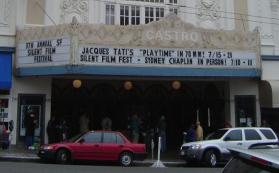 In July the historic Castro Theater played host to the 9th Annual San Francisco Silent Film Festival. Film buffs were in for a treat as a wide assortment of rare and hard to see movies were screened over the weekend. All of the films featured live accompaniment preformed by a talented group of musicians. It is hard to imagine a better venue for enjoying these old films. It is commonly accepted that 85% of all silent films are lost. Back in the early days of film, movies were looked on as disposable entertainment, to be shown until the prints wore out and then disposed of. The 15% that remain are often hard to see, with only an occasional showing of some of the better-known titles at art house theaters or on college campuses. Even if you are fortunate enough to have access to such screenings, they are invariably with prerecorded music and often with old and worn prints. That is why the Silent Film Festival is such an exciting event. It is a wonderful opportunity to experience historically important films in a unique setting. Traveling from my home in Florida all the way across a continent seemed like a small inconvenience to be able to experience these films the way they were originally intended to be seen. The festival went to great lengths to provide an enjoyable venue to view the films, but the festival was more than just the old movies. It also played host to several authors signing their books on classic film, there were interviews with stars and authors, and even a demonstration of Tango dancing before the screening of The Four Horsemen of the Apocalypse. All of the films had informative introductions by various film scholars. The most interesting prefaces were the ones in which the musicians discussed the music that would be played and the process by which it was selected. Between events slides were shown giving information on the directors and actors in the upcoming film, while period music was piped into the theater. Listening to Al Jolson and Fanny Brice while seeing stills of Douglas Fairbanks and Rudolph Valentino was a delightful way to fill the time between screenings. You never know whom you'll end up sitting next to either. There were film buffs of every stripe. I encountered Reginald Denny and Norma Shearer aficionados, fans of early German films, and even a lot of old time radio fans. (Another love of mine.) There were long time fan of early movies, as well as people who have recently discovered silent films. Consequently, the conversations that popped up were all very interesting and informative. Where else can you sit next to someone and start up a conversation about Russian directors like Sergei Eisenstein and Andrei Tarkovsky, and then have people all around you join in? It was an enjoyable experience. The main attractions of the festival were the films of course. Almost none of the movies shown are available on DVD,1 and all of the films screened were from 35mm prints (the vast majority of which had been restored) and featured live accompaniment either on a grand piano or the Castro's Wurlitzer Organ (with the single exception of The Circus which used the original orchestral score that Chaplin recorded for the film's rerelease in 1970.) All of the music that was played was excellent and enhanced the movies to a great extent.

Blue Bird This film was wildly inventive, and fill with unusual creatures and events. In many ways it is reminiscent of The Wizard of Oz with its similar quest-like plot. Tourneur, who is best known for The Poor Little Rich Girl staring Mary Pickford and the 1920 version of Last of the Mohicans, was trained as an artist and he had an excellent eye for composition. Many of the shots looked like paintings, and there were many very creative and unusual visuals scattered throughout the film (the personification of fire was one of my favorites.) Tourneur used silhouettes and inventive lighting effects to give this film the feel of a German expressionist film. What is amazing is that this was made the year before The Cabinet of Dr. Caligari, the film that would showcase many of these types of visual techniques to great effect. The print of this film that was screened was the Eastman House restoration, which won the festival's Haghfilm award this year for film preservation. Blue Bird is an amazing film that was very much ahead of its time. This inventive and visually interesting film was a great opener.
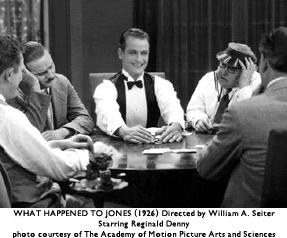 What Happened to Jones The next film to be screened was What Happened to Jones? a light comedy from 1926 staring Reginald Denny. I was familiar with Denning's many supporting roles in the talking era, but hadn't seen any of his silent comedies prior to attending this festival. I was surprised to find that this film was basically a screwball comedy, generally thought of to have started in the 30 and 40's. It includes all of the trademarks of that genre; mistaken identity, embarrassing situations, misunderstandings, switched genders and witty banter. This movie was uproariously funny. Denning plays Tom Jones, a man who is about to be married. The night before his wedding, Tom gets drawn into an illegal card game that, as luck would have it, gets raided by the police. Escaping in the initial confusion, poor Tom spends the rest of the movie on the run from the police, finding himself in a series of uncomfortable situations, each one more outrageous than a last. Denning's manner and style were very reminiscent of that master of the screwball farce, Cary Grant. Denning's charm and easy attitude, coupled with his quick wit and good looks made him appear to be the ideal average American man. It is too bad that his strong British accent regulated him to supporting roles (often as English aristocrats) when movies switched over to sound. This great movie is rarely screened, and showcases Denning comedic ability, something that a modern audience don't often get a chance to see. 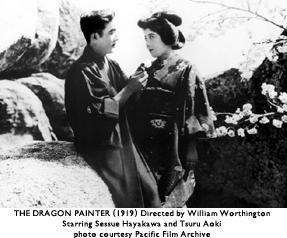 The Dragon Painter The Festival presented a very rare treat to attendants this year. Midori Sawato, a master Benshi artist from Japan, accompanied the 1919 Sessue Hayakawa film The Dragon Painter. Katsuben (providing narration to silent films) is an art form that is unique to the Japanese silent era. The intertitle cards to many imported films were not translated into Japanese, and the Benshi read out translations of the dialog so the partons could understand the movie. But they did much more than that, the Benshi gave each actor a different voice and filled in the plot and added dialog of their own. Along with the accompanying music, they created the illusion of a talking picture. At the height of the silent era, the Benshi themselves were a greater draw than the stars in the movies that were showing. Partons would attend a show just to see their favorite Benshi artists perform. The famous director Akira Kurosawa's older brother was a very popular and influential Benshi. It was through his brother's art that the young Akira, who was studying art at the time, discovered the potential and power of film. With the coming of sound though, like live theatrical orchestras, the Benshi have all but died out. Even in Japan it is hard to see a Benshi performance today, much less here in the States, so I was looking forward with great anticipation to Midori Sawato's presentation. I was not disappointed. Ms Sawato first narrated, in English, a samurai short that had title cards in Japanese, something she has never done before. Though her accent was fairly heavy and some of her dialog was hard to make out, her narration gave the movie an extra dimension. She not only read dialog in different character voices, she also included background on the period when the movie takes place and lyrically described some of the scenes that we were watching. Ms Sawato didn't just read along to the movie, she interpreted it, and her performance enhanced the film greatly. After the short, The Dragon Painter was screened with katsuben performed by Midori Sawato again, but this time in Japanese. Though I didn't understand the language, her accompaniment was still an asset to the film. Even with the language barrier you can feel the emotion and feeling in her voice as she does the various characters. I was surprised as how much larger the movie felt with the Benshi accompaniment, and the live music performed by the Mark Izu Ensemble was simply excellent.
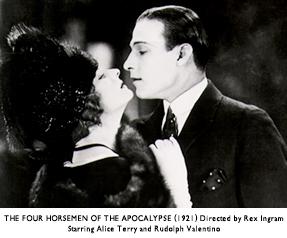 The Four Horsemen of the Apocalypse Saturday's programming closed out with an evening screening of the Rex Ingram classic The Four Horsemen of the Apocalypse. This is the movie that turned Rudolph Valentino into an international superstar overnight. The print was a restored copy from the Warner Brothers vaults, and it looked very good. The famous Tango scene, which started a fad here in the US and elsewhere around the world, was much longer than other prints that I have seen. Warner's had allowed that dance sequence to be used in documentaries and retrospectives over the years, and most of the dance is actually missing from the WB negative, hence the reason for the abbreviated version that most of us are used to seeing. But for this restoration, various prints from around the world were used to piece together the full sequence. It is easy to see why Valentino was considered a sex symbol after this film. He simply exudes charm and charisma when he is on the screen. I found the parts without Valentino to drag a little, but when he was present the movie seemed to flow effortlessly. The movie was accompanied by Dennis James on the Castro Theater's Wurlitzer Organ. He preformed the score compiled for the movie's original release. Mr. James did an amazing job playing the organ for the 2 1/2 hours that the film ran seemingly effortlessly. 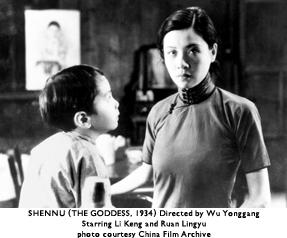 Shennü (The Goddess) The second day of the festival was filled with an even more enticing line-up than the first. First to be shown was Shennü (The Goddess.) This 1934 Chinese silent film starred the legendary actress Ruan Lingyu. Though not a household name today, Ruan was an international star in the 30's. When she tragically killed herself a year after this movie was made, the number of mourners who turned out for her funeral rivaled that of Rudolph Valentino's. In this film Ruan plays a prostitute who sells her body at night to pay to send her son to school. Shunned and ridiculed by the neighbors because of her profession, and tormented by a local gambler who steals her earnings, the young lady has few choices in her life. The social commentary in this movie is accentuated by Ruan's subtle and heartfelt performance. For a more in-depth look at this movie, you can read the review of the DVD available here. 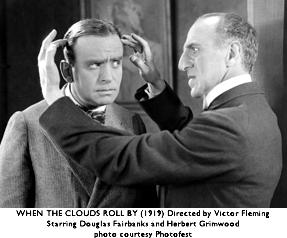 When the Clouds Roll By Most people are familiar with Douglas Fairbanks swashbuckling action pictures. But before he buckled his first swash, to steal a joke from the film's introduction, Fairbanks became famous in a series of light comedies where he used his athletic ability for comic effect. The screening of the decidedly odd, but very humorous, When the Clouds Roll By shows just how effective he was at this type of acting. Fairbanks plays Daniel Boone Brown, a superstitious young man who is unknowingly the subject of a scientific experiment. The doctor that lives across the hall, Dr. Ulrich Metz, is testing his theory that psychological upheaval can be enough to drive a man to suicide. His test has worked well so far. The young man is having trouble sleeping and is constantly bothered by strange nightmares. He's perpetually late for work, which causes him to get suspended. Then things start looking up when he encounters a lovely girl in the park who is just as superstitious. This seems to throw a wrench in the doctor's plans, so he doubles his efforts. Will this love cause the neferious plan's to fail, or will the pressure be too much for young Daniel Brown? This was a fun film to watch. You know this was going to be a different sort of film right from the start. The credits include footage of the director directing, the writer writing, and photographers filming, which sets the tone for this movie's odd sense of humor. Of course the film is just getting started. The early scene of an onion and lobster dancing around in Douglas Fairbank's stomach was truly unique. One thing that did surprise me was the way some of the jokes were set up. You could tell that Fairbanks (who wrote the outline) didn't have a fine-tuned sense of humor. The timing is off on some of the jokes, and others weren't set up correctly. Sometimes when they made it plain that a joke was coming, the anticipation of a gag was more humorous than the gag itself. The beginning was wildly creative, as was the giant flood scene at the end of the film, but the middle was a more standard light comedy. Even so, this was a very enjoyable film with a sidesplitting conclusion. Following When the Clouds Roll By, the audience was treated to a rare Fairbanks short, 1916's The Mystery of the Leaping Fish. This is one short you will NEVER see aired on TCM or any other TV station. It is one of the most bizarre shorts I've had the pleasure to see. The festival program states that you have to see it to believe it, but even after seeing it, I'm still not sure I believe that this short was ever made. This broad parody of Sherlock Holmes features Fairbanks as the famous detective "Coke Ennyday." Coke is sitting at home in his chair, shooting up whenever he feels himself coming down from a high and drinking odd mixtures of absinthe and acid when the police chief comes to his door needing his help. A man has checked into a seaside resort and is spending large sums of cash with no visible means of support. Will Coke go down and check the man out? After taking a huge inhalation from his gallon-sized tin of cocaine, he agrees and sets off for the seaside. A favorite pastime at the beach is riding the 'leaping fish;' inflated fish shaped balloons that people body surf on. Coke runs into a beautiful young girl (Bessie Love) who works at the leaping fish rental shack as their 'fish blower.' (First seen from behind hunched over and bobbing her head up and down as she blows up a fish.) Together they set out to find the mysterious man and find out the source of his riches. It was well worth the trip just to see this incredibly bizarre and strange short.
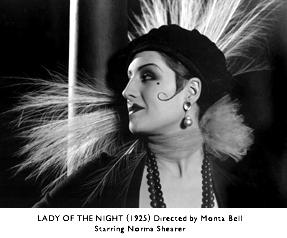 Lady of the Night I really wasn't looking forward to the Norman Shearer film Lady of the Night. I'm not really a fan of melodramas in general, and silent melodramas are often the worst. They are usually very sappy and feature overacting with predictable scripts. So it was with the anticipation of falling asleep part way through the movie that I started to watch the next feature. Well, my eyelids didn't even grow heavy. Yes, this is a melodrama that tugs on your heartstrings, but Norman Shearer's performance was incredible. She managed to keep the film interesting and fun, while still being serious, a rare talent indeed. Norma plays the dual role of two women who were both born at the same time. Molly's father was a criminal and only saw her once before being sentenced to prison where he would eventually die. Florence was the daughter of the rich Judge Banning who sent Molly's father to jail. The two girls grow up in totally different worlds with Florence going to finishing school while Molly goes to reform school. Molly is dating Chunky (George K. Arthur,) and the two get along just fine until she meets David (Malcolm McGregor) one night at a dance hall. David is poor but hard working and Molly immediately falls in love with him. David is working on an invention, and manages to perfect a machine that will make it possible to open any safe. Chunky offers to sell the device to some crooks, but Molly pleads with David to sell it to bankers and not to get tied up with criminals. David takes her advice and eventually sells his invention to a group of investors lead by Judge Banning. Florence happens to bump into David while he's visiting her father, and the two start dating, much to Molly's horror. This typical love triangle story is anything but average. The script is first-rate, with all of the characters being fully fleshed out people with strengths and weaknesses. Norma Shearer does an absolutely wonderful job acting as both the rich Florence and the struggling and crass Molly. Her performance was subtle and understated, yet fully relating the depth of emotion and sentiment of the scenes. This was one of my favorite films shown this year.
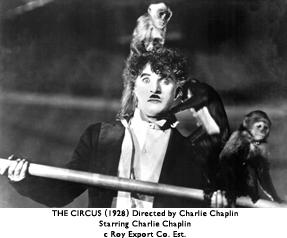 The Circus The last film to be screened at this year's festival was the classic 1928 Charlie Chaplin comedy The Circus. This is a great film, which I reviewed as part of the Chaplin Collection Volume Two, so I won't repeat myself here except to say that viewing this film in a sold out theater of silent movie fans beats watching it at home any day. I found myself laughing uproariously at some of the scenes that I had only thought were average, and the best scenes played even better. The print was the recently restored MK2 version, which looked phenomenal. After the screening a reel of outtakes was shown, along with an interview with Sydney Chaplin, Charlie's son who was born during the making of this film. Sydney was an accomplished actor in his own right, winning a Tony award, and staring in the original run of Funny Girl opposite Barbra Streisand. He told a few interesting anecdotes about his father, including what Charlie did with the first Oscar he was awarded. (He told the Academy that they were not qualified to judge his art and used it as a doorstop.) This years Silent Film Festival was a wonderful event. The movies were absolutely excellent, both in content and quality of the prints. The programming ran smoothly and any problems that may have cropped up were invisible to the audience. The volunteers and staff were all courteous and helpful. It is rare to see so many high quality silent movies in such a nice venue that this is an event that all fans of classic movies should try to attend. If you weren't able to make it to San Francisco this year, it has been confirmed that there will be another festival next year, so start making your plans now! 2005 will be the festival's tenth anniversary, and they are sure to have some special events planned. Stay apprised of the latest developments here on DVDTalk and through the San Francisco Silent Film Festival's own web site, www.silentfilm.org.
- John Sinnott
Archives
The 2013 San Francisco Silent Film Festival
The 2009 San Francisco Silent Film Festival Douglas Fairbanks - A Modern Musketeer The General - Kino's Ultimate 2-Disc Edition Compete Archives
Review Staff
| Newsletter Subscribe
| Join DVD Talk Forum
|
| |||||||||
| |||||||||||